Related Research Articles

Serfdom was the status of many peasants under feudalism, specifically relating to manorialism, and similar systems. It was a condition of debt bondage and indentured servitude with similarities to and differences from slavery. It developed during the Late Antiquity and Early Middle Ages in Europe and lasted in some countries until the mid-19th century.
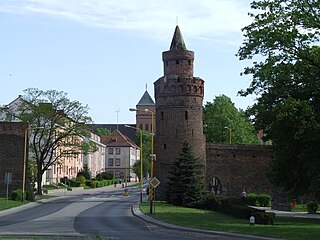
Pyrzyce is a town in Pomerania, north-western Poland. As of 2007, it had 13,331 inhabitants. It is the capital of the Pyrzyce County in West Pomeranian Voivodeship.
City rights are a feature of the medieval history of the Low Countries. A liege lord, usually a count, duke or similar member of the high nobility, granted to a town or village he owned certain town privileges that places without city rights did not have.
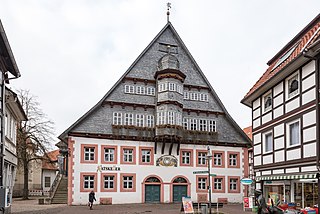
Osterode am Harz, often simply called Osterode, is a town in south-eastern Lower Saxony in central Germany on the south-western edge of the Harz mountains. It was the seat of government of the district of Osterode. Osterode is located on the German Timber-Frame Road.

Demmin is a town in the Mecklenburgische Seenplatte district, Mecklenburg-Western Pomerania, in north-eastern Germany. It was the capital of the former district of Demmin.

The Lot was a unit of measurement of mass, which was mainly used in German-speaking states of the Holy Roman Empire and in Scandinavia.

Municipalities are the lowest level of official territorial division in Germany. This can be the second, third, fourth or fifth level of territorial division, depending on the status of the municipality and the Land it is part of. The city-states Berlin and Hamburg are second-level divisions. A Gemeinde is one level lower in those states which also include Regierungsbezirke as an intermediate territorial division. The Gemeinde is one level higher if it is not part of a Gemeindeverband.

Cotter, cottier, cottar, Kosatter or Kötter is the German or Scots term for a peasant farmer. Cotters occupied cottages and cultivated small land lots. The word cotter is often employed to translate the cotarius recorded in the Domesday Book, a social class whose exact status has been the subject of some discussion among historians, and is still a matter of doubt. According to Domesday, the cotarii were comparatively few, numbering fewer than seven thousand people. They were scattered unevenly throughout England, located principally in the counties of Southern England. They either cultivated a small plot of land or worked on the holdings of the villani. Like the villani, among whom they were frequently classed, their economic condition may be described as free in relation to everyone except their lord.
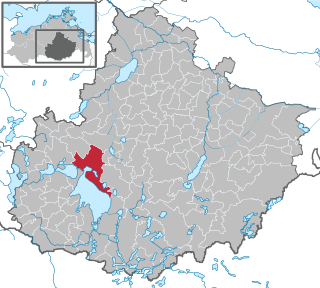
Waren (Müritz) is a town and climatic spa in the state of Mecklenburg-Vorpommern, Germany. It was the capital of the former district of Müritz until the district reform of 2011. It is situated at the northern end of Lake Müritz, approximately 40 kilometres west of Neubrandenburg. Waren is home to the offices of the sub-district (Amt) of Seenlandschaft Waren, although the town itself is independent of any Amt. Its borough is the second largest in Mecklenburg-Vorpommern by area.
The total registered electorate in the United Kingdom grew from 5.7 million in 1885 to over 21 million in 1918. Much of the growth was result of the Representation of the People Act 1918, which expanded franchise by abolishing property qualifications for men and introduced female suffrage for some women over the age of 30.

Ahrenshoop is a municipality in the Vorpommern-Rügen district, in Mecklenburg-Vorpommern, Germany on the Fischland-Darß-Zingst peninsula of the Baltic Sea. It used to be a small fishing village, but is today known for its tourism and as a holiday resort.
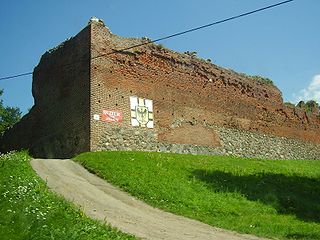
Starostwo of Draheim or Drahim was a starostwo of the Polish kingdom from the 15th century, seated in Draheim. Pawned to Brandenburg-Prussia in 1657, it was directly incorporated into the Kingdom of Prussia in 1772 as Amt Draheim and the Town of Tempelburg.
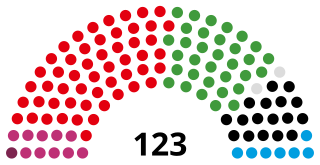
The Hamburg Parliament is the unicameral legislature of the German state of Hamburg according to the constitution of Hamburg. As of 2020 there are 123 sitting members, representing 17 electoral districts. The parliament is situated in the city hall Hamburg Rathaus and is part of the Government of Hamburg.

German heraldry is the tradition and style of heraldic achievements in Germany and the Holy Roman Empire, including national and civic arms, noble and burgher arms, ecclesiastical heraldry, heraldic displays and heraldic descriptions. German heraldic style is one of the four major broad traditions within European heraldry and stands in contrast to Gallo-British, Latin and Eastern heraldry, and strongly influenced the styles and customs of heraldry in the Nordic countries, which developed comparatively late. Together, German and Nordic heraldry are often referred to as German-Nordic heraldry.
Grand Burgher [male] or Grand Burgheress [female] is a specific conferred or inherited title of medieval German origin and legally defined preeminent status granting exclusive constitutional privileges and legal rights. Grand Burghers were magnates and subordinate only to the Emperor, independent of feudalism and territorial nobility or lords paramount.
The Bürgergemeinde is a statutory corporation in public law in Switzerland. It includes all individuals who are citizens of the Bürgergemeinde, usually by having inherited the Bourgeoisie (citizenship), regardless of where they were born or where they may currently live. Membership of the Bürgergemeinde of a municipality is not to be confused with holding the municipality's citizenship, which, in certain cantons such as Valais, are two distinct legal concepts. Instead of the place of birth, Swiss legal documents, e.g. passports, contain the Heimatort. It is, however, possible for a person to not possess bourgeoisie of the municipality from which they originate; laws relating to these matters vary depending on the canton in which the Bürgergemeinde is located. The Bürgergemeinde also often holds and administers the common property which had been bequeathed or otherwise given to the members of the bourgeoisie. The political communes or municipalities, the parish and the Bürgergemeinde often include the same area but may be separate depending on the relevant cantonal law. With the increase in mobility since the first half of the 19th century, the Bürgergemeinde and the rights associated with citizenship in the municipality have lost most of their meaning. Today, in Switzerland there are nearly 2000 Bürgergemeinden and corporations.

The Bergregal was the historic right of ownership of untapped mineral resources in parts of German-speaking Europe; ownership of the Bergregal meant entitlement to the rights and royalties from mining. Historically, it was one of those privileges that constituted the original sovereign rights of the king.
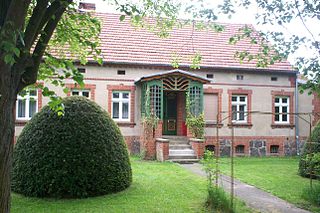
Banzendorf is a village in the state of Brandenburg, Germany. Since the end of 2001 it is a component locality (Ortsteil) of the municipality of Lindow, Ostprignitz-Ruppin district.
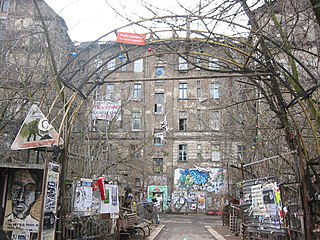
Køpi is a housing project located at 137 Köpenicker Straße in Mitte, Berlin. It was squatted in 1990 and legalised in 1991 as an autonomous housing project and self-managed social centre. The yard was used as a wagenplatz for people living in vehicles. It is a left-wing project, connected to punks, anarchists and Autonomen. The building has become a symbol for the radical left in Berlin in the same manner as Rozbrat in Poznań or Ungdomshuset in Copenhagen. It has survived several eviction attempts both through political pressure and because the developers have always run out of money.
References
- ↑ Beatrice Morning (2016). "Introduction: Lodgers in rural and urban Europe in the past". Continuity and Change. 31 (1): 1–8. doi: 10.1017/S0268416016000072 .
- ↑ Friderich von Flerssheim (1882). "Weisthum und Gerichtsordnung der Gemeinde Ellerstadt vom Jahr 1555". Zeitschrift der Savigny-Stiftung für Rechtsgeschichte. Germanistische Abteilung. 3 (1): 199–223.
- 1 2 Marianne Messerer (2008). Die Unterschichten der ländlichen Bevölkerung mit Beispielen aus dem Weinviertler Museumsdorf Niedersulz (PDF) (Thesis). Universität Wien. pp. 58 ff.
- ↑ "Einlieger". Meyers Großes Konversations-Lexikon. Vol. 5. 1905. p. 461.
- ↑ Michael Mitterauer (1992). "Inwohner — Problem der Familienzugehörigkeit". Familie und Arbeitsteilung. Historischvergleichende Studien (PDF). Böhlau Verlag Wien, Köln, Weimar. p. 198. Archived from the original (PDF) on 2016-07-11. Retrieved 2016-07-12.
- ↑ "Instleute". Meyers Großes Konversations-Lexikon. Vol. 9. 1905. p. 876.
- ↑ Method Dolenc (1929). "Die niedere Volksgerichtbarkeit unter den Slovenen von Ende des 16. bis Anfang des 19. Jahrhunderts". Jahrbücher für Kultur und Geschichte der Slaven. Neue Folge. 5 (3): 299–368. JSTOR 41039938.
- ↑ Johann N. Schneid (1835). Das Brautexamen, die Eheeinsegnung, die Jubelehe und das Verfahren der katholischen Kirche bei Aufnahme eines fremden Religionsgenossen in ihre Gesellschaft: ein Hilfsbuch zunächst für angehende Geistliche und Seelensorger: mit einer Zugabe von Tauf-und Leichenreden. G. Joseph Manz, Regensburg und Landshut. p. 10.
- ↑ Franz Wilfingseder (1952). Geschichte der Herrschaft Lustenfelden bei Linz (Kaplanhof). Sonderpublikationen zur Linzer Stadtgeschichte. Linz: Buchverlag der Demokratischen Druck- und Verlags-Gesellschaft.